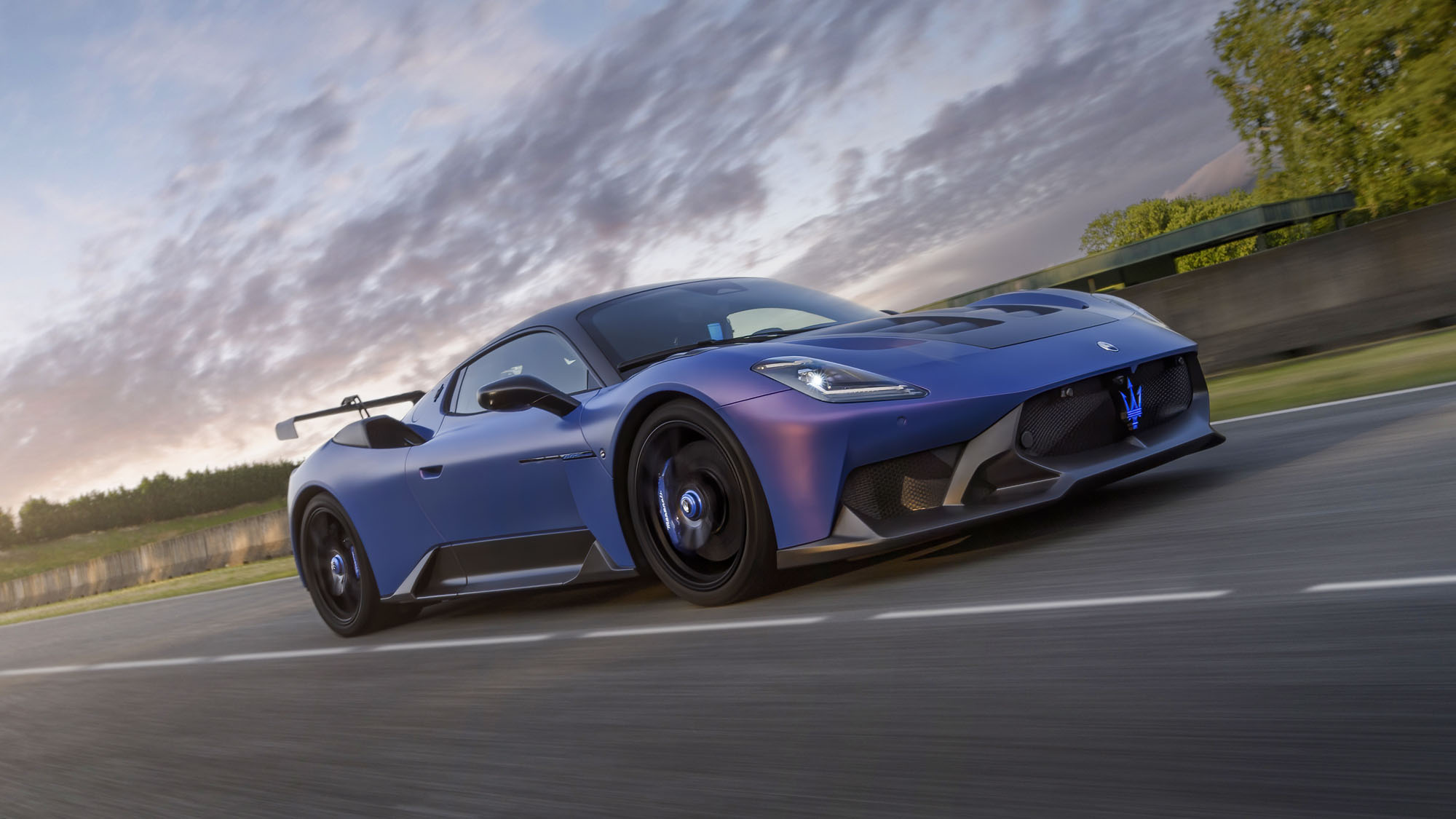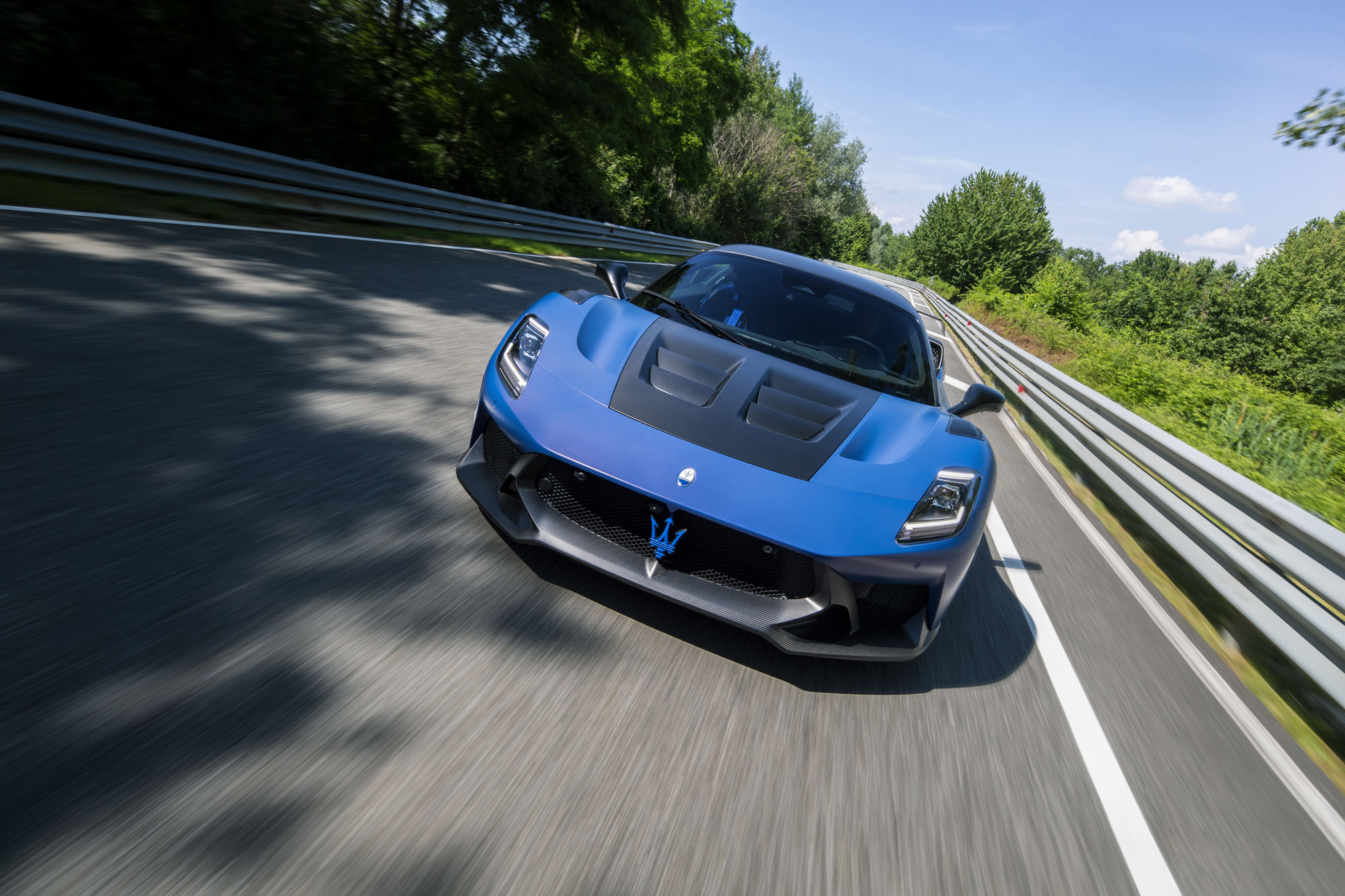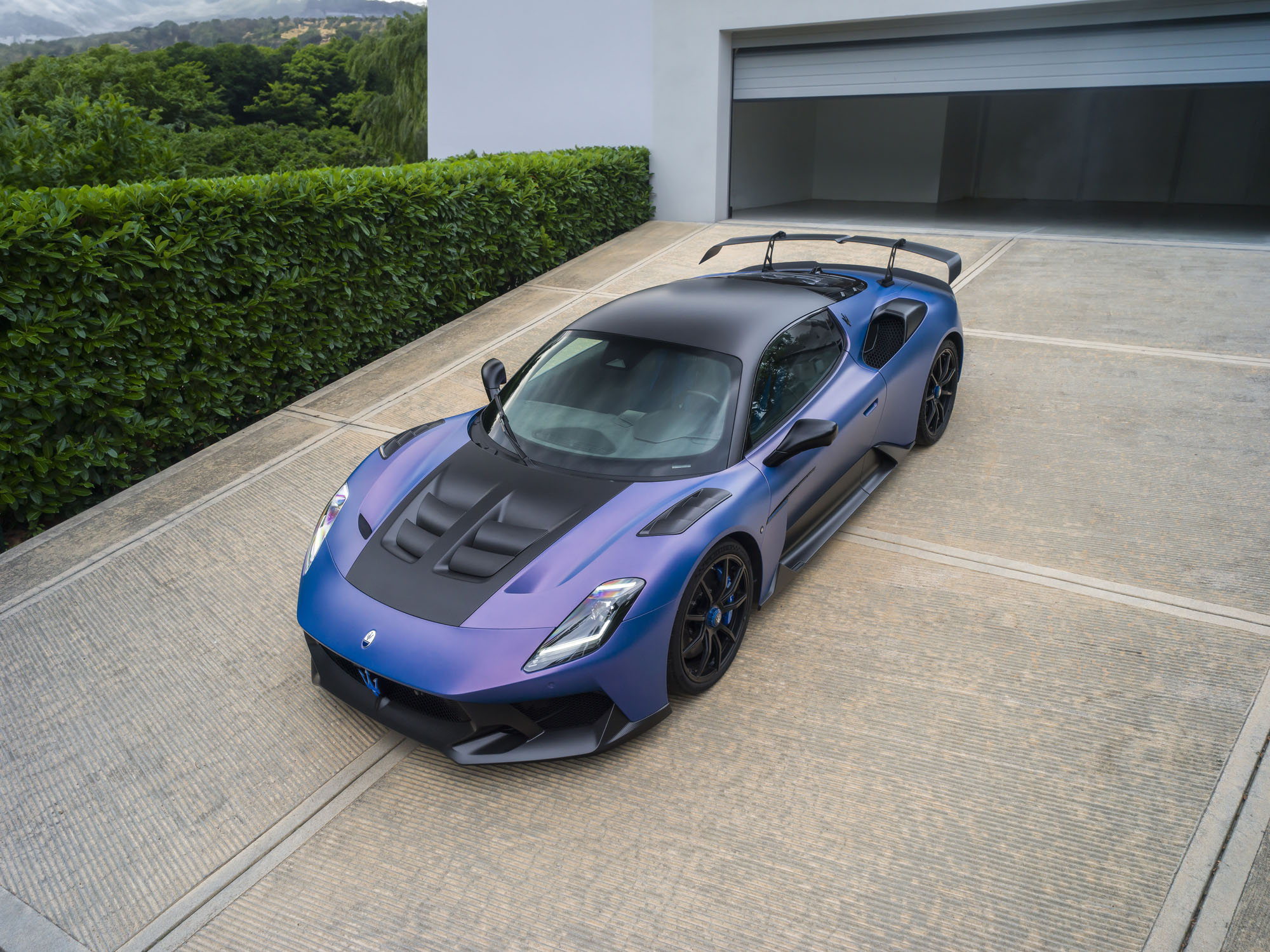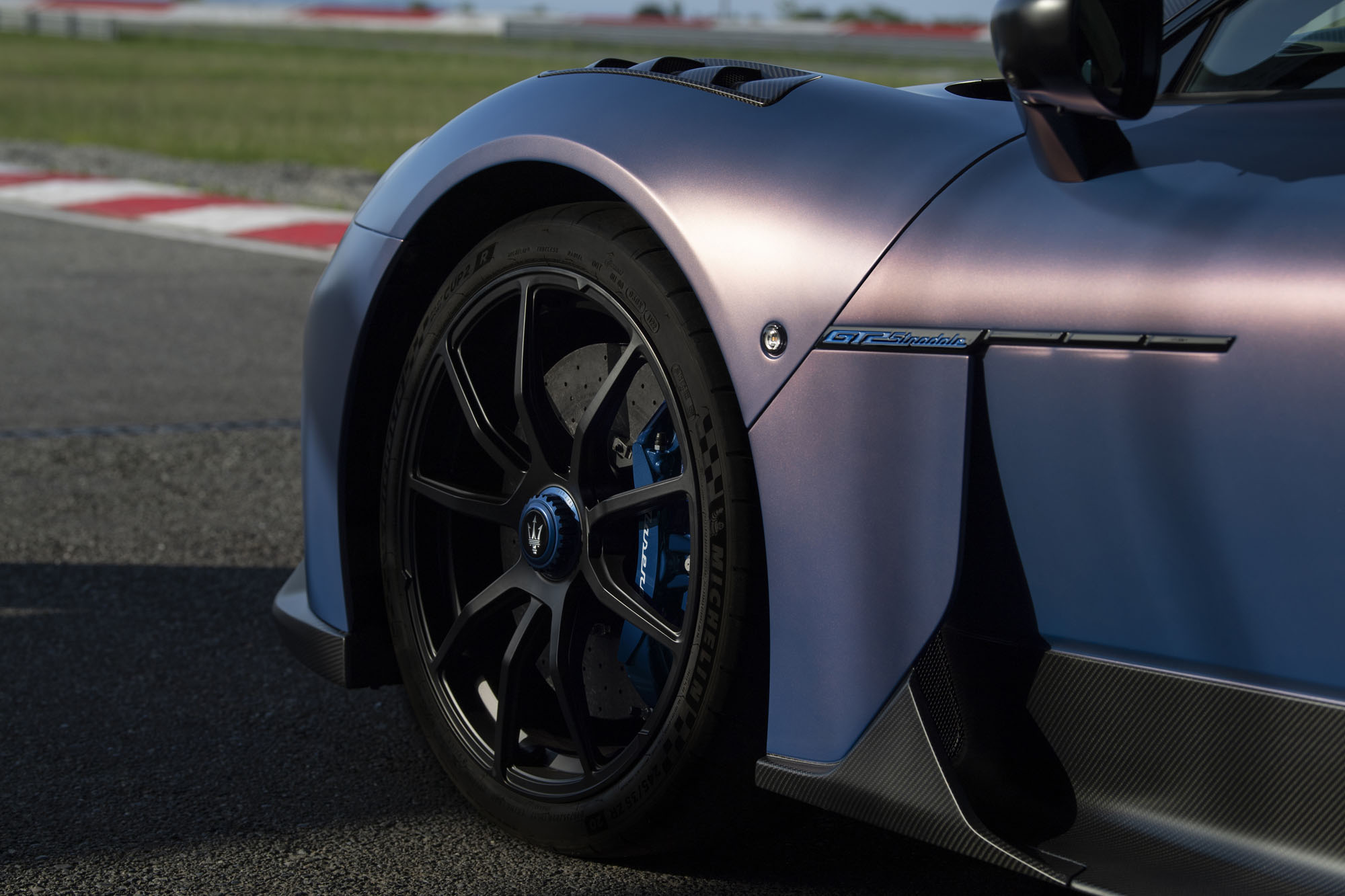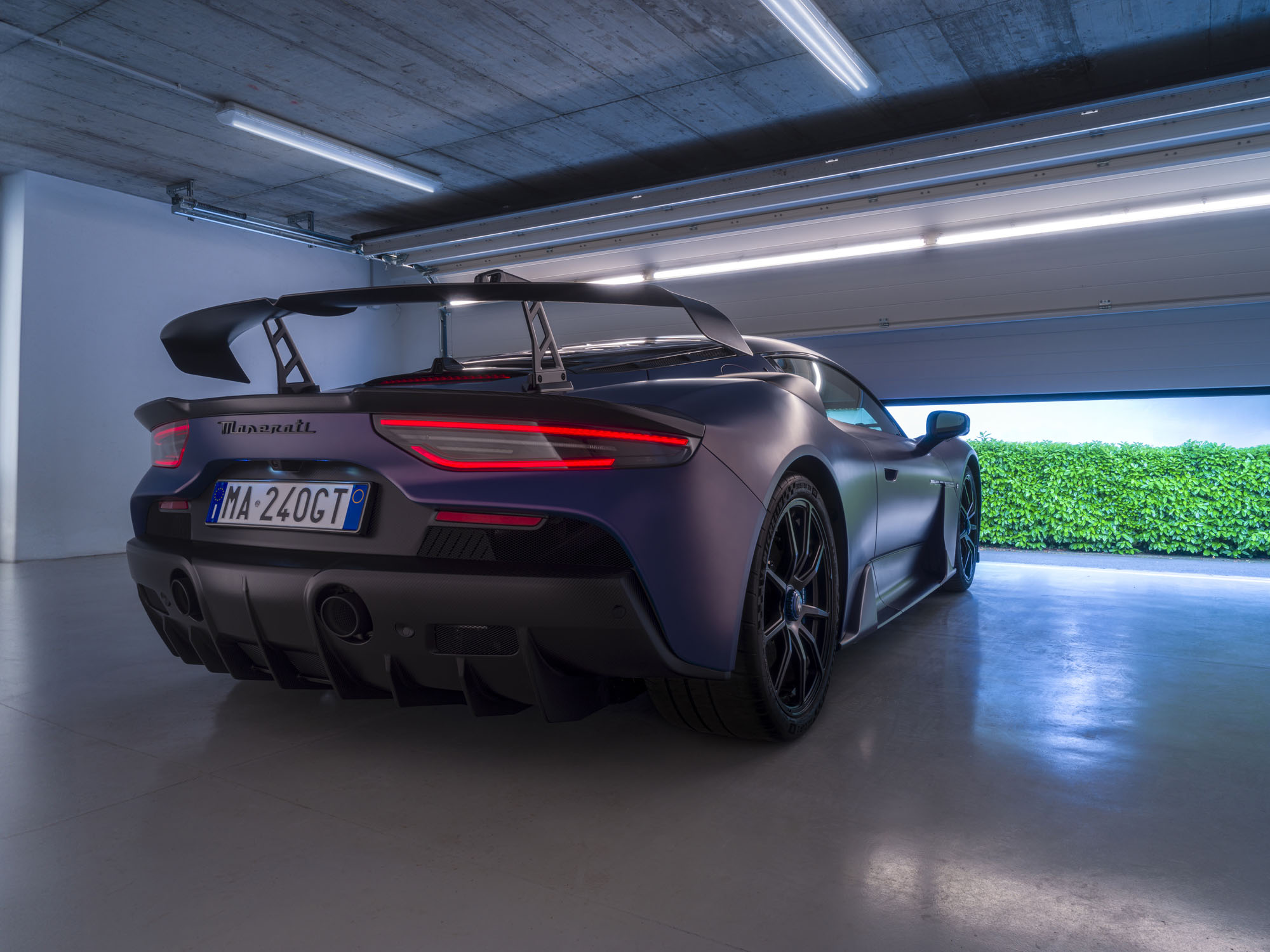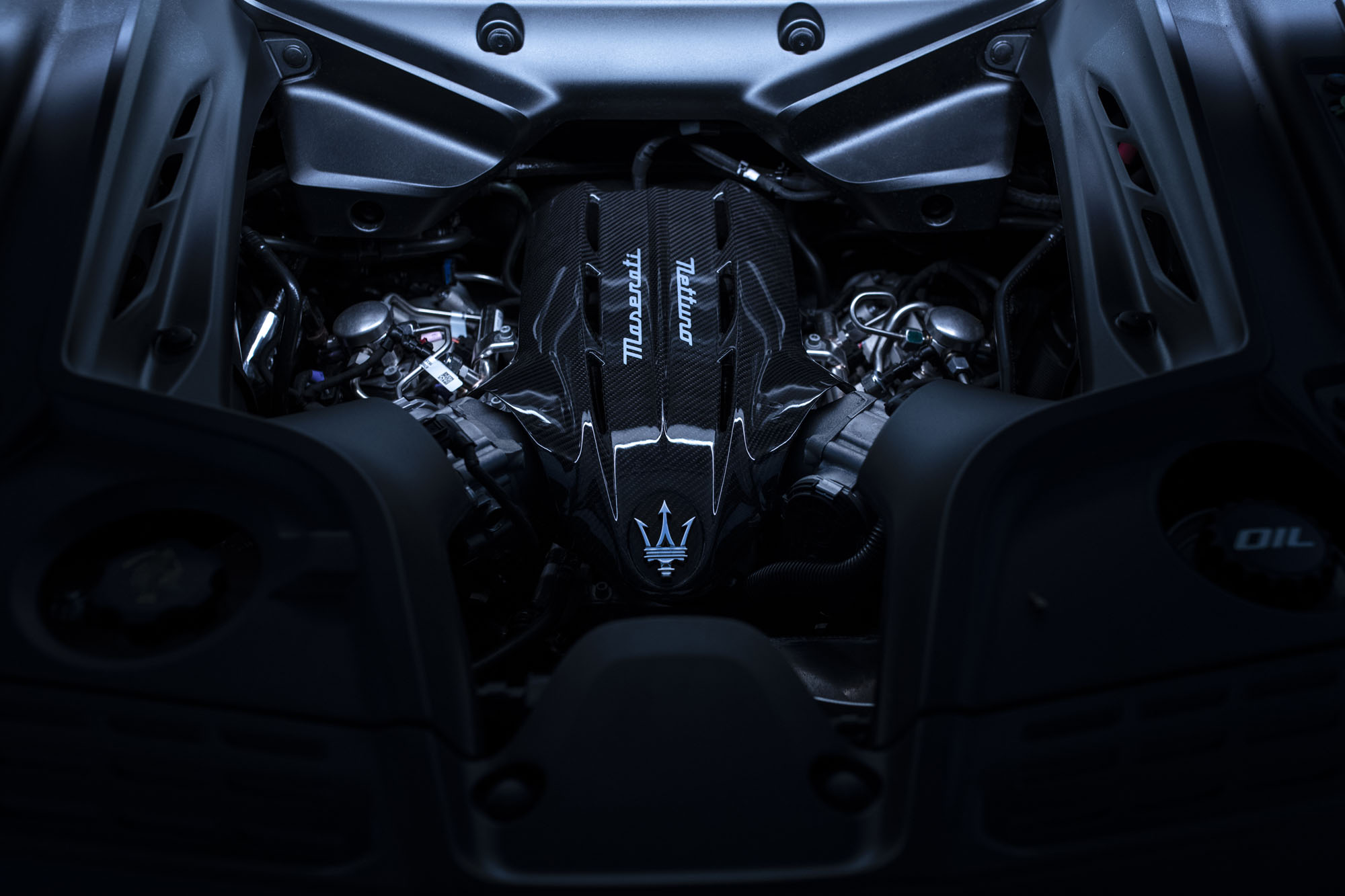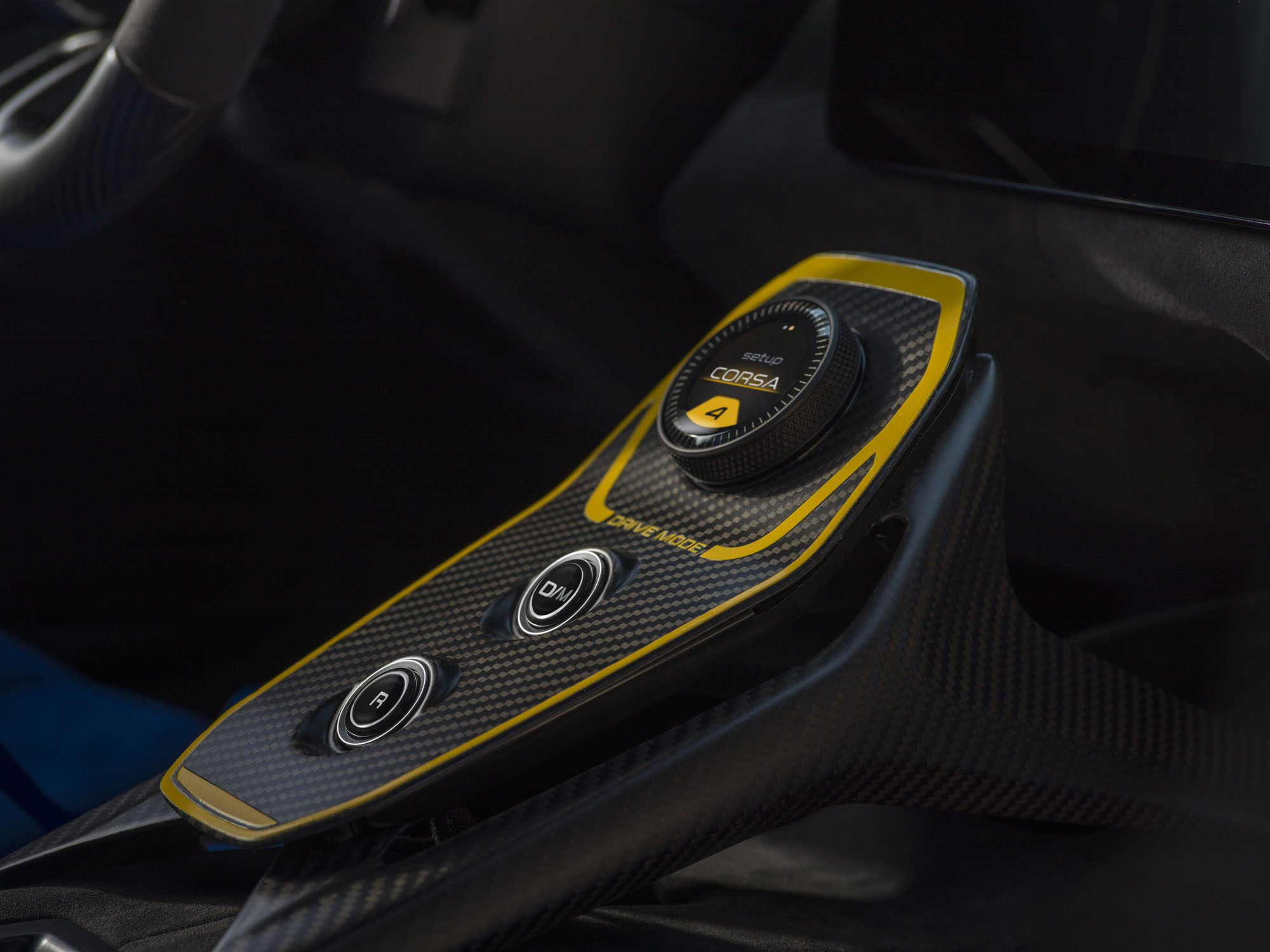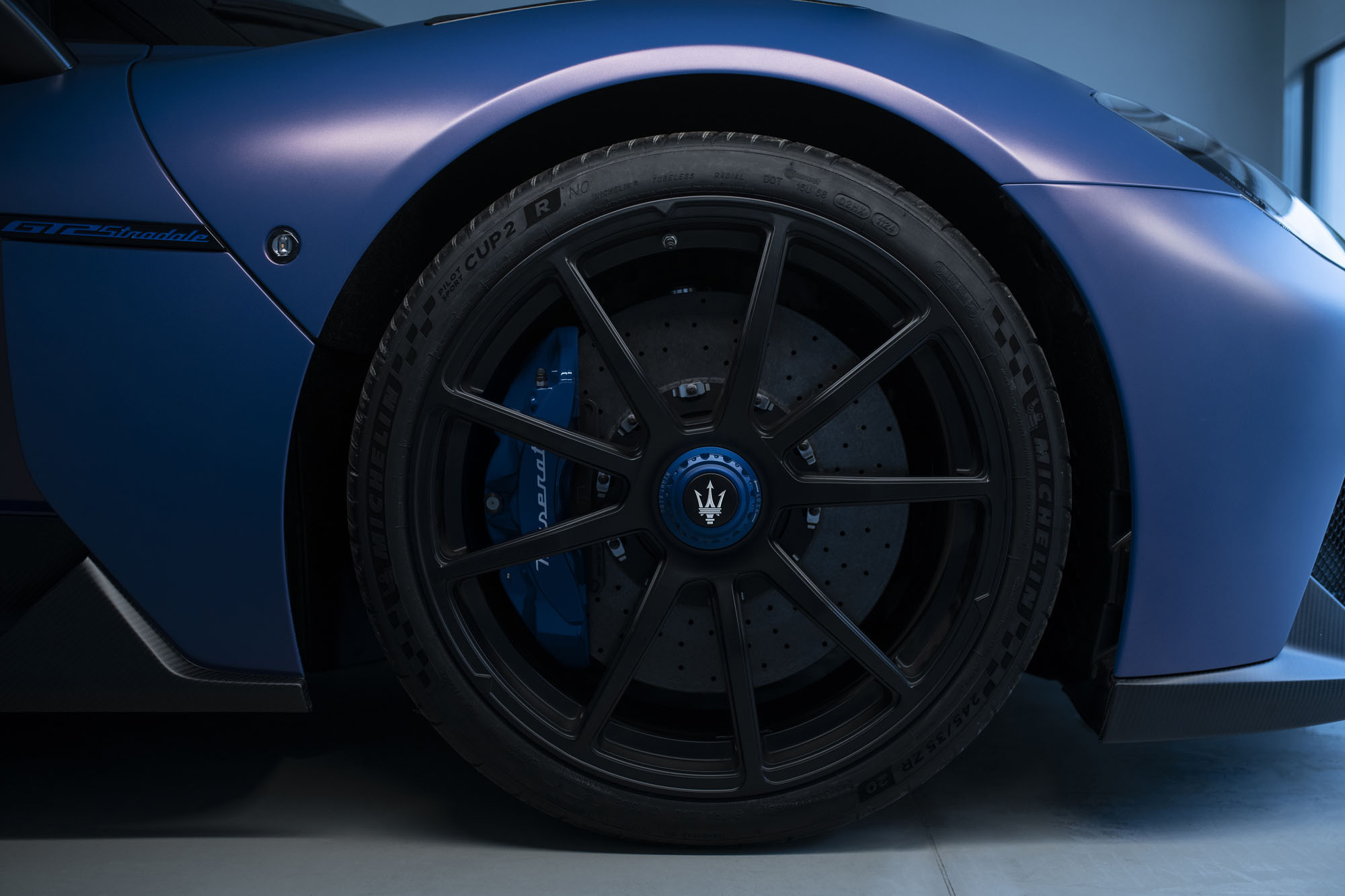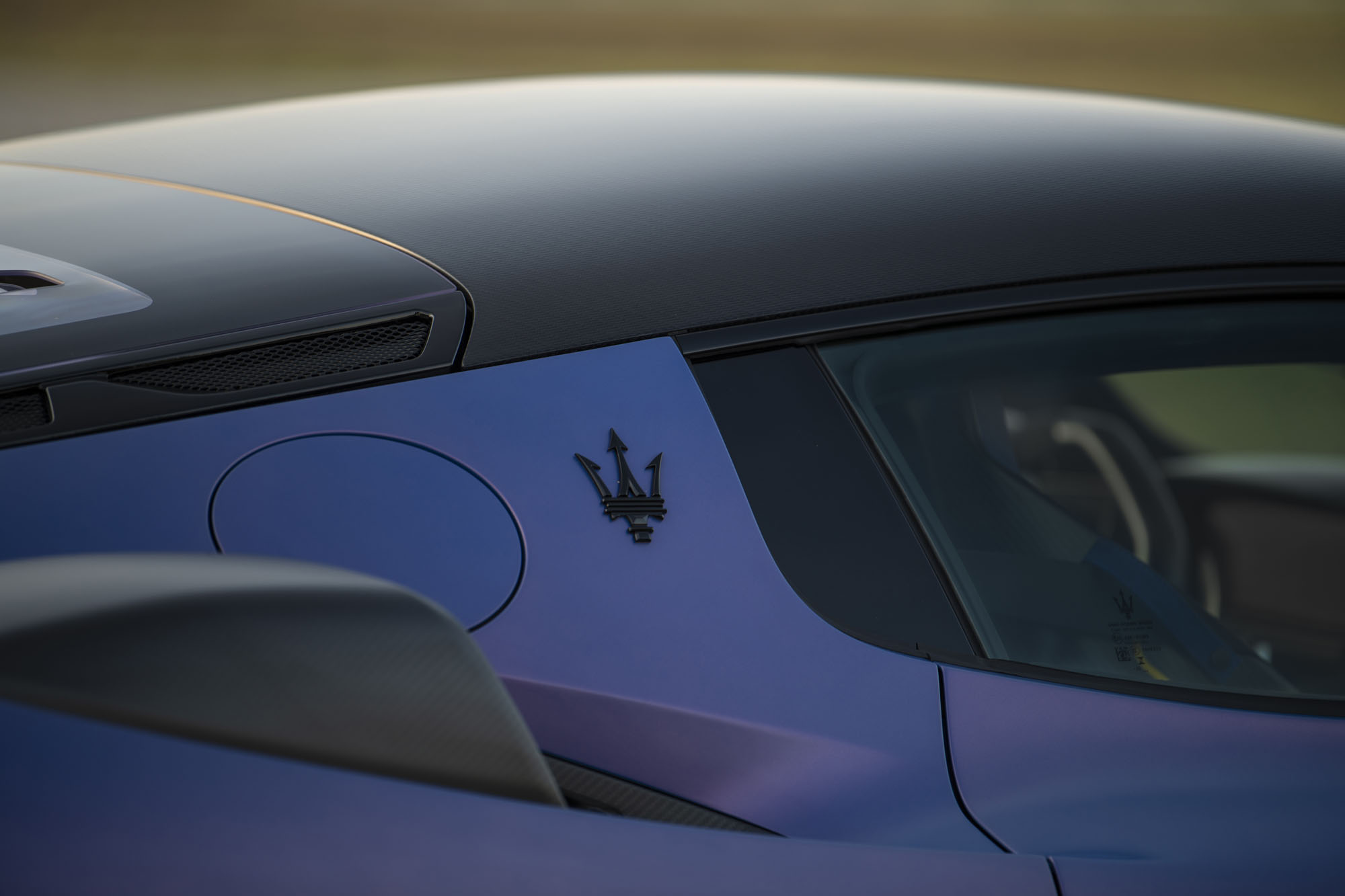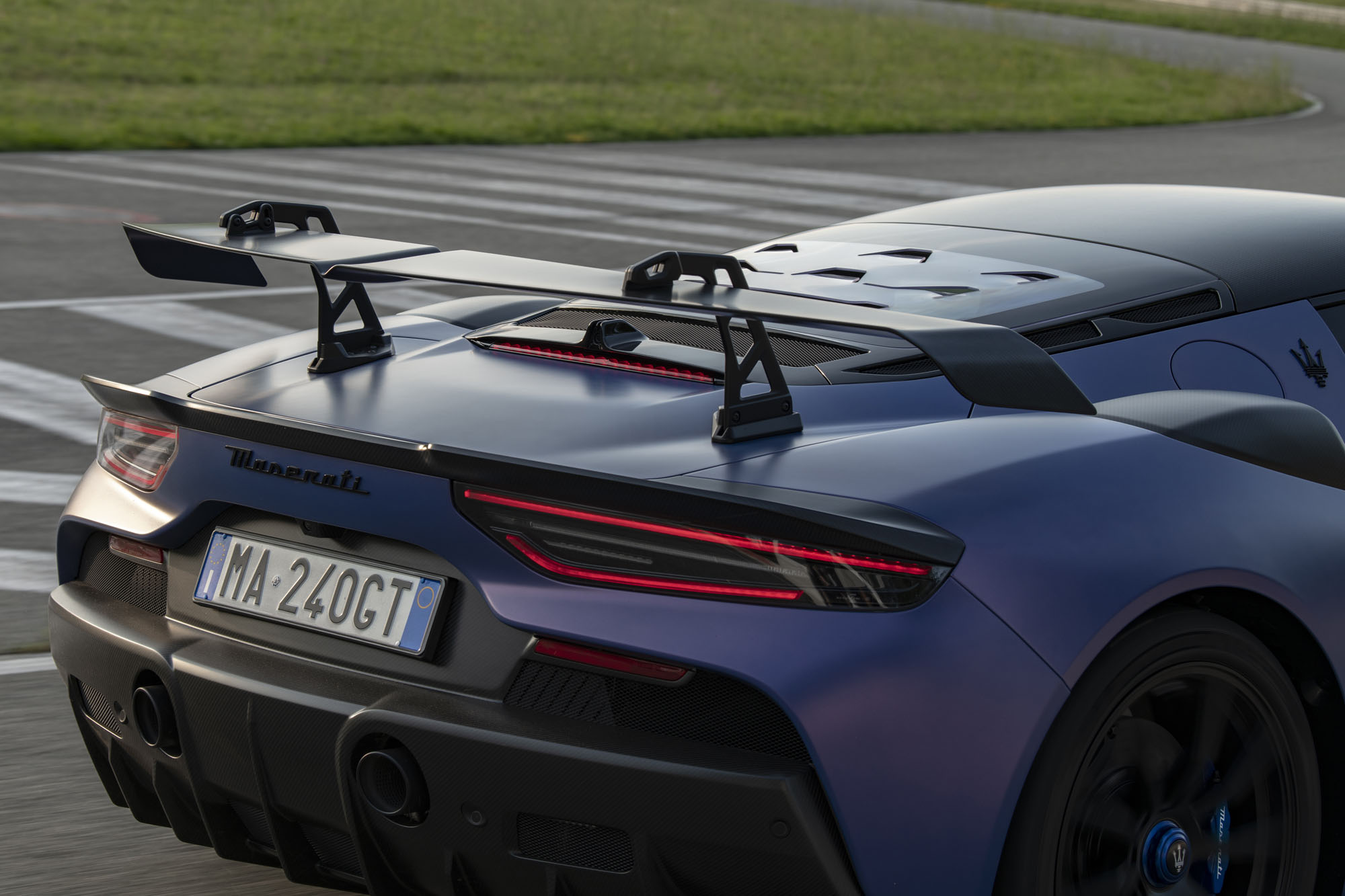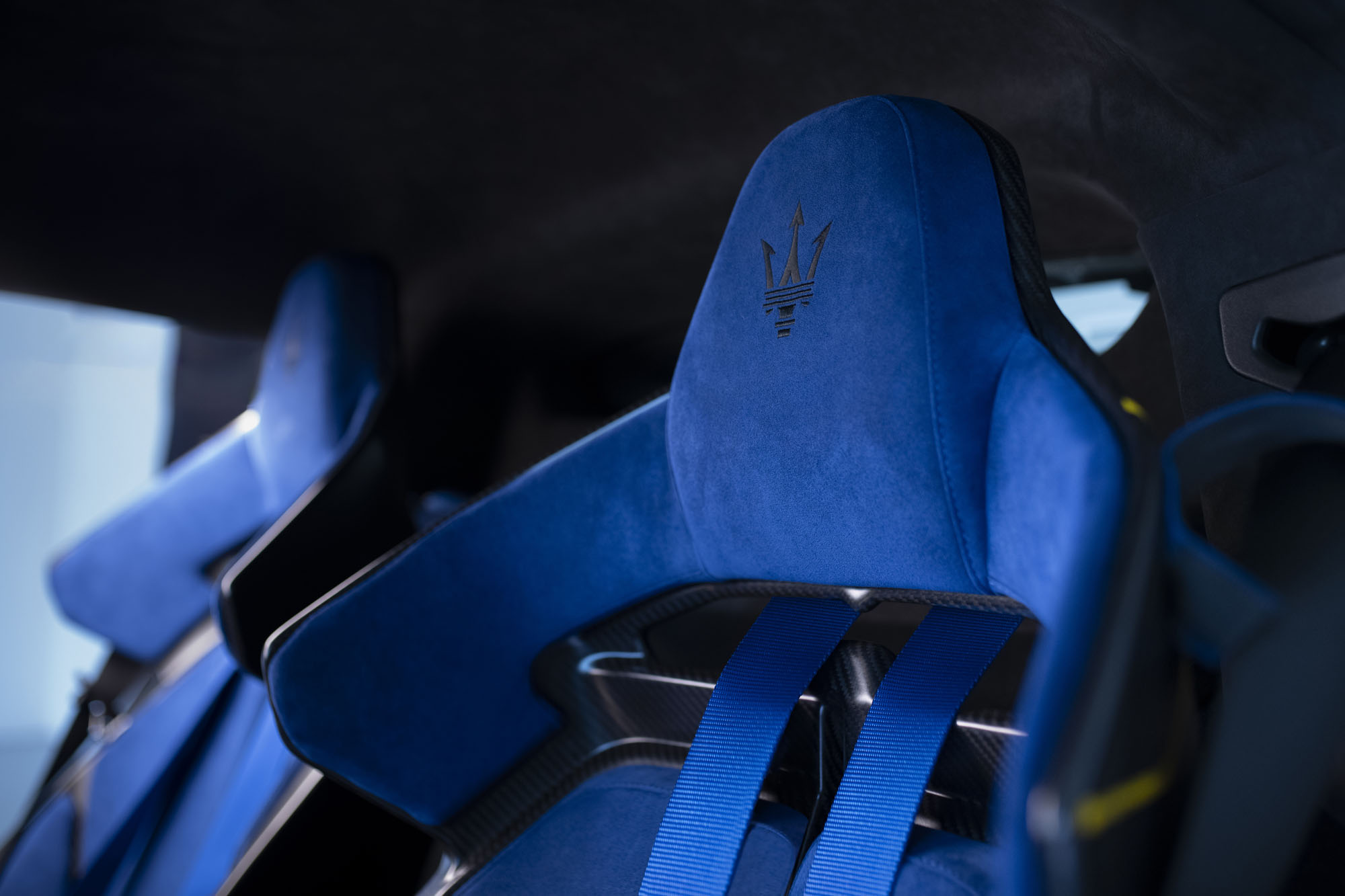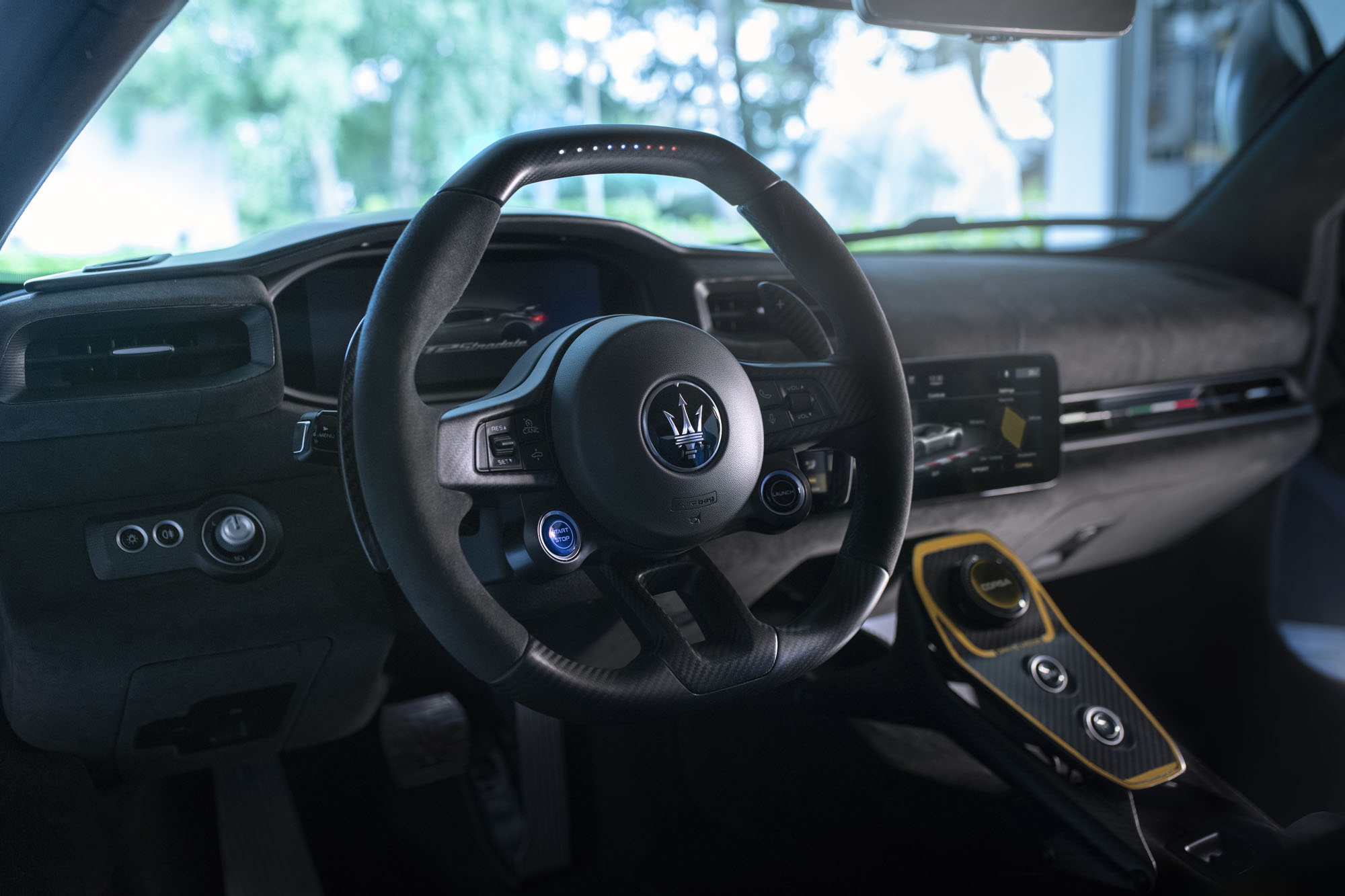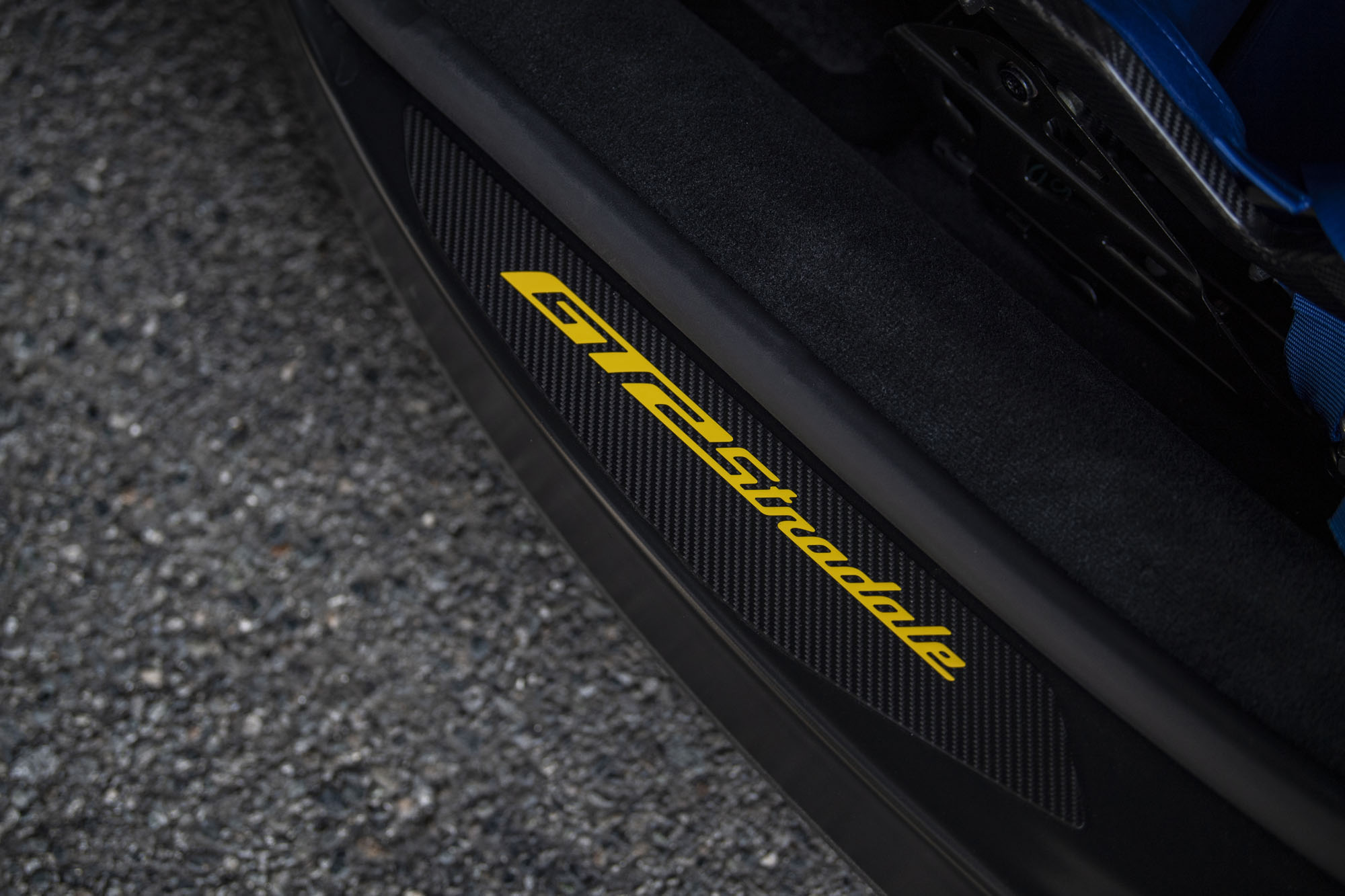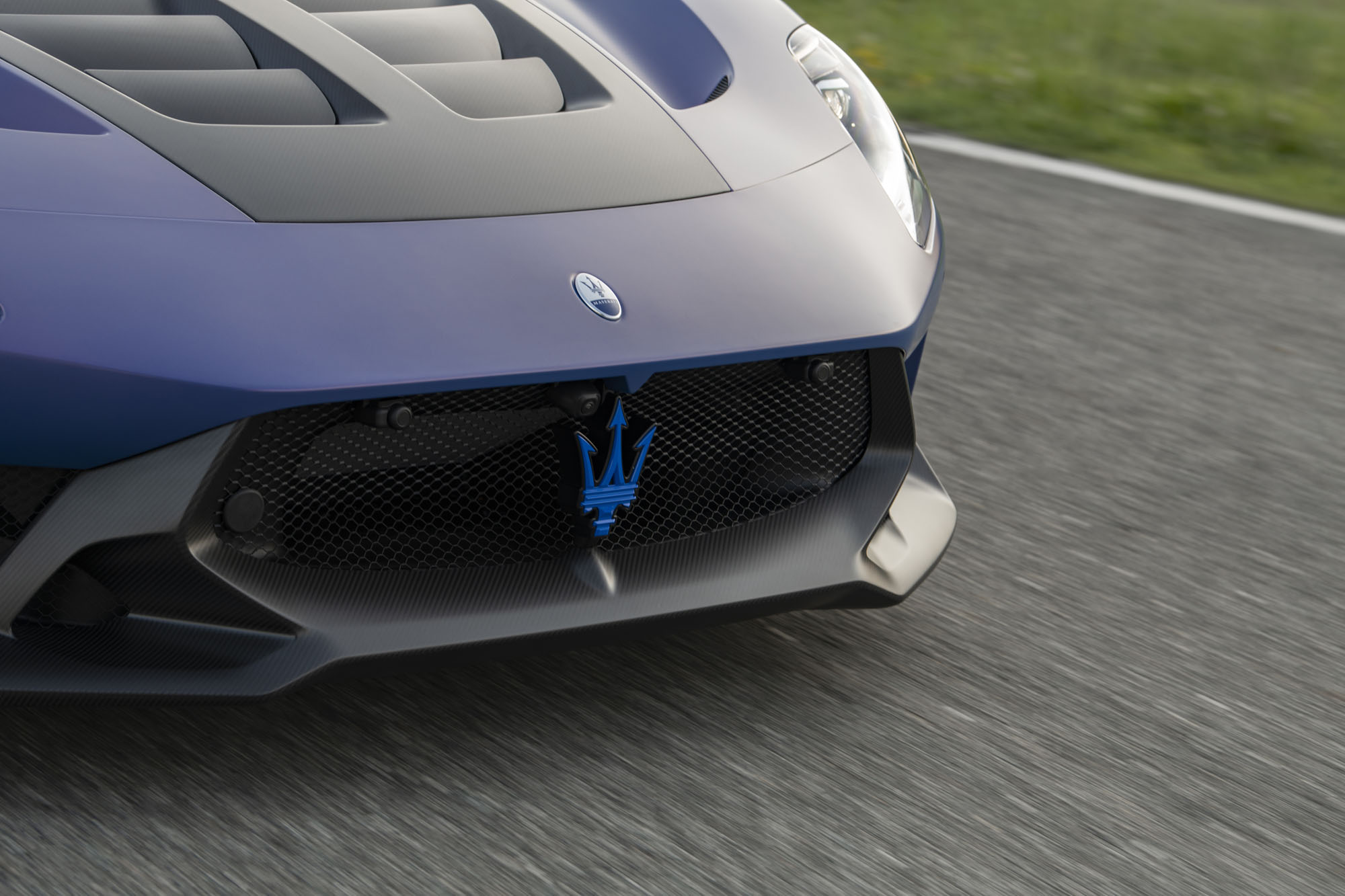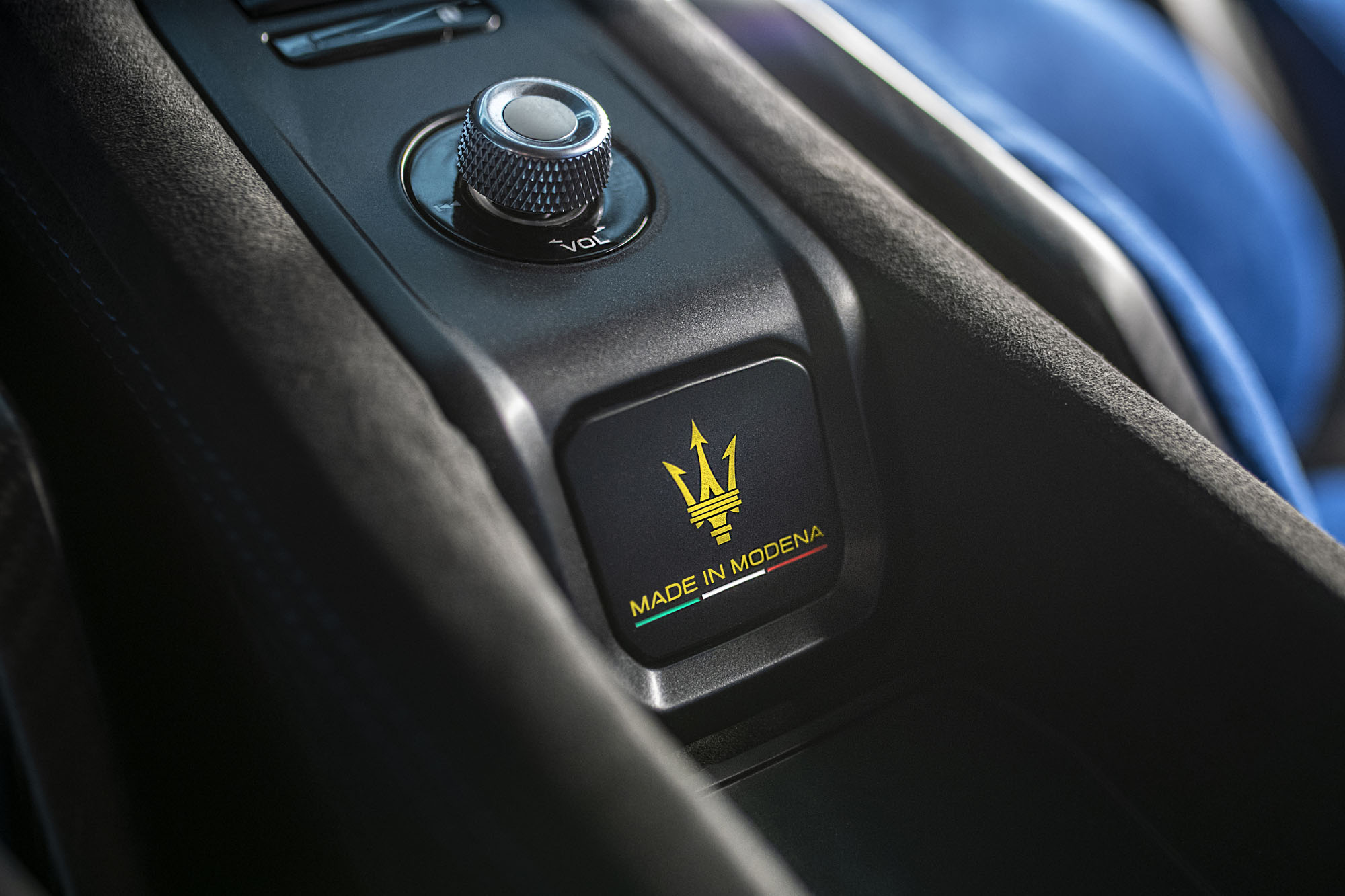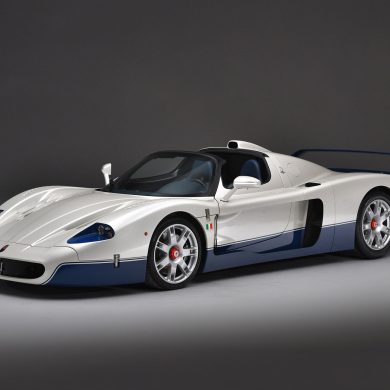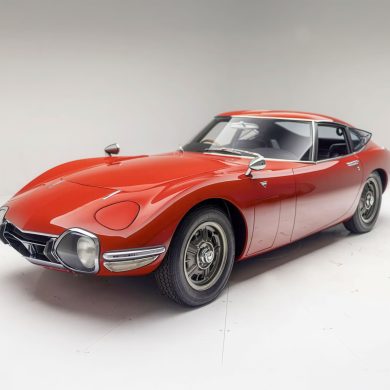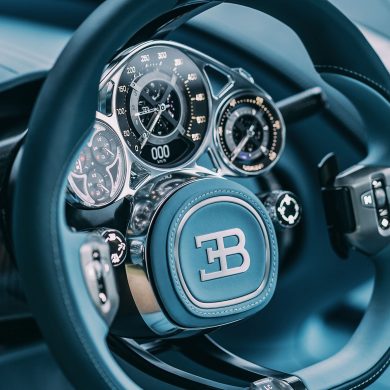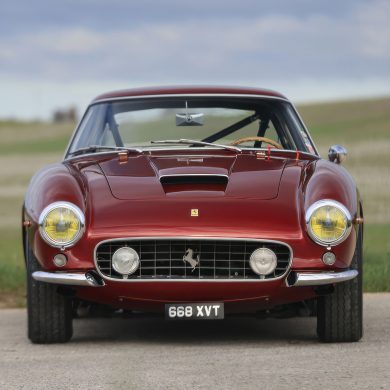The result of a technical and stylistic partnership between the Maserati GT2, a masterpiece of performance, and the Maserati MC20, an iconic Trident car imbued with an unmistakable style, the new Maserati GT2 Stradale is an ode to the most extraordinary and exclusive sportiness from Italy. Introduced during Monterey Car Week in August, the GT2 Stradale became an overnight success, turning heads of sports car aficionados worldwide.
The essence of Gran Turismo
The Maserati GT2 Stradale combines in-depth technology transfer of the purest performance, typical of a racing car, combined with the intrinsic qualities of the MC20. The new super sports car thus evokes style and racing performance while ensuring an ideal feeling and comfort in all conditions of use without sacrificing the best driving experience on the road, typical of Maserati’s offering.
With a top speed of over 320 km/h, maximum output increased to 640 hp (10 hp more than the MC20), weight decreased by 60 kg and acceleration from 0 to 100 km/h in just 2.8 seconds, Maserati GT2 Stradale promises unparalleled sensations and superior performance, partly thanks to its sophisticated aerodynamics and attractive design inherited from its racing sibling. At the wheel, the feeling will be one of driving one of the most incredible track cars there is, with the opportunity to make the best of it on roads worldwide.
Interview with Giovanni Perosino
Before we delve into the mind-numbing details of the modern sports car, Sports Car Digest was on the ground at Car Week in Monterey and spoke with Maserati’s Chief Marketing Officer, Giovanni Perosino, regarding the true essence of the GT2 Stradale.
SCD: Maserati continues to advance its cars both technically and performance-wise, but I’m wondering how you approached the emotional side of customers’ expectations with the new GT2 Stradale?
GP: Thank you so much for being here….we are sincerely grateful for the excitement this car is producing here in Monterey. The enthusiasm is really amazing. Yes, we have done our homework from a technical point of view, but what we also consider essential is injecting the Grand Turismo essence into each vehicle. The Grand Turismo “concept” is traveling with pleasure, comfort and confidence.
For example, for those that have driven the Maserati MC20, their first reaction was often “Wow…it’s very easy to drive.” So we want to always have some of that in every car that we build to stay in line with the Gran Turismo character. With the GT2 Stradale, many of its enthusiasts have a little more “Racing is life” attitude. However, with the incredible performance of this car comes the ease which it is required to drive it.
SCD: Given the level of performance this car provides, I would think it’s even harder to build it to enable this higher level of comfort and ease of driving, compared to other cars of the same performance.
GP: Exactly. It is very challenging and more complex to build a car that is this fast but easier to drive than its competitors. When you look it at now, it appears to be a beautiful and emotional car, which is what we wanted to build. And yet, it’s very capable on the track too.
SCD: Could you share some feedback you get in conversations with customers who have just driven a Maserati on track?
GP: Because we are Italian, we always want a little audacity and “wow” in our vehicles. But with Maserati, we execute this in the Gran Turismo style. I like to refer to this as “Effortless Elegance.” During our design process, we always question ourselves, “Is this idea long-lasting, or is it just a trend?” We always want a long-term ownership experience, so our cars must reflect lasting design.
A New Era
When Maserati started work on the MC20 project, the halo car that marked the beginning of a new era for the House of the Trident, it had already decided to return to the track. After the launch of the MC20, the upshot was the Maserati GT2, which took the Modena-based manufacturer back to racing victory in the 2023 Fanatec GT2 European Series Championship. Even so, leaving so much power and beauty only on the track would have been a waste. Here then is the Maserati GT2 Stradale, another legitimate daughter of the MC20 – sister of the GT2 only type-approved for the street – the state-of-the-art Maserati performance.
GT2 Stradale is definitely a high-tech model that can provide extreme performance on the track, but it is also a welcoming car that can be used on an everyday basis, courtesy of the level of comfort and specifications such as ADAS. It can therefore even be driven in the city, with aids such as cameras and parking sensors, now essential for a certain category of cars.
Engine
The GT2 Stradale’s Nettuno, an engine designed and constructed in-house by Maserati, is a true “Made in Modena” gem: it maintains the 90° V-shaped 6-cylinder twin-turbo layout, with 3.0 litres of displacement and dry sump, capable of delivering 640 hp (471 kW) at 7500 rpm and an outstanding 720 Nm of torque starting from 3000 rpm. The weight-to-power ratio is 210 hp/L. The compression ratio is 11:1; the stroke is 82 mm and the bore 88 mm.
The soul of this engine remains the innovative pre-chamber combustion system with twin spark plugs, a technology developed for Formula 1 and now also available on the Maserati GT2 Stradale. The system is based on three main components: the pre-chamber placed between the central spark and the traditional combustion chamber; the side spark plug, which acts as a support to ensure regular engine combustion when the latter is working in operating points where the use of the pre-chamber is not necessary; and the dual indirect and direct injection system to ensure the perfect mix of fuel and air.
Turbochargers and exhaust manifolds are modified for higher boost pressure and efficiency at peak power and lower back pressure due to the different exhaust system, to guarantee the same level of performance on all tracks all around the world.
Drive modes
From a technical point of view, the configuration of the chassis has been revised, making it more rigid. E-LSD, electronic controls and specific drive mode setups have been optimized for greater grip, related to the semi-slick tires and aerodynamic downforce to make track use even more thrilling. The various drive modes, which can be selected using the control on the center console, adjust gear change performance, electronic calibration of the shock absorbers, EDIFF electronic differential, steering, ABS for racing tires and ESC with specific thresholds.
The drive mode selector takes center stage on the tunnel, as the distinctive feature that reminds the driver and passenger they are aboard a Maserati. And a Maserati with exceptional performance. In the latest digital version, already admired in the MC20, the drive mode selector is inspired by luxury watches: mechanical, precise, using prestigious, top-quality materials, with a touch of Maserati’s typical blue. It recalls the luxury that envelops anyone who gets into a car from the House of the Trident. The decision for the drive mode selector to resemble a luxury watch was a symbolic one, especially considering the lack of the usual Maserati analogue clock on the MC20 dashboard.
The GT2 Stradale has four specific drive modes: WET, GT (the default setting on engine start-up), SPORT and CORSA, also available in four further variants that progressively reduce the electronic controls when opting for the Performance Pack.
Suspension
The same suspension geometry as developed for the track version has been used for the GT2 Stradale. The new geometry enhances the MC20’s already excellent handling in the most severe conditions, with no compromises on performance whatsoever. The double triangle arrangement is confirmed, with UNIBAL® joints for maximum rigidity.
The steering system benefits from dedicated racing calibration, and the brake system is adapted to severe track usage with specific ventilated discs, calipers and pads, and an optimized cooling system. The specific carbon-fiber ducts have been designed to flow fresh air directly to the wheel hub area. The ABS system is also specific and is calibrated to different settings.
In the center of the driving mode selector, there is a button to adjust the suspension to make it softer or more rigid. It is useful in SPORT or CORSA modes when the suspension is extremely stiff. Pressing the “suspension” button makes the suspension more comfortable and less rigid. This is particularly useful on uneven ground, as it gives the driver a sporty yet simultaneously comfortable driving experience.
Gearbox
The automatic transmission is an 8-speed oil-immersed dual clutch design with two overdrive speeds to ensure emissions compliance. To further emphasize the car’s sportiness, the time it takes to change gears has been reduced.
Braking system
The braking system is new, developed with Brembo specifically for the GT2 Stradale as a step forward from the first-generation carbon-ceramic brakes. The diameter and thickness of the discs have been increased, to improve driving performance. This geometry requires more cold air to lower the system temperature, achieved by adding a new cooling brake at the front and rear, where the air entering from the sill has been partialized.
Exterior
Once again, the Maserati GT2 Stradale was created at the Maserati Centro Stile. The work of the men and women at the Centro Stile focused on attention to the design of all areas of the car, where changes have been made for the type approval of the GT2, maintaining an extraordinary level of performance without neglecting the sporty spirit successfully brought to the road by the Maserati MC20.
The front features a new design, maintaining the typical Maserati architecture and adapting to requirements in terms of cooling and aerodynamics; the forms are functional to the vehicle dynamics. The front ‘mouth’ (known in development as the “shark nose”) has been broadened, ensuring greater airflow and introducing an aesthetic concept that will be seen again in future Maserati models.
Maserati designers have worked on the redesign of the front to maintain the assertiveness of the GT2, as well as the sporty spirit and functionality, with intakes to bring in fresh air for cooling purposes. The front bonnet was also developed and previously introduced in the racing version (GT2); the GT2 Stradale takes it up in full, with adaptation for the specific aerodynamic requirements of load balancing and expelling hot air.
The number three and the revisited Trident are again a constant in the style of the Maserati GT2: there are three air vents in the bonnet, another three in the front wheel arches, three more near the rear window, and nine-spoke wheel rims, forming a Trident in threes. The area around the front fender has been revamped with the introduction of air outtakes in the upper part of the fenders (from the GT2), to let out hot air to cool the brakes and reduce the pressure inside the wheel arches.
On the other hand, the air intakes in the rear fenders have been completely redesigned and enlarged, producing a new carbon-fiber cupola to improve the flow of cold air (+16%), supply the engine, and cool the radiators. The carbon-fiber spoiler has been revised compared to the MC20 design, increasing its surface area, and the wing with a boomerang design and built-in endplates has been added. The all-new rear wing, inspired by the GT2’s, is connected to the car with pylons as structural poles in solid aluminum. The fastening system offers three different adjustments with the same number of levels of aerodynamic downforce. To support the load, the bonnet area has been reinforced.
In the rear, the large extractor stands out, completely redesigned to facilitate the extraction of air from the underbody, to generate downforce, and to make the car more assertive. The exclusive design of the lower area was created based on input from aerodynamics to push performance to the max; revisions have also been made to the racing version. Seen from behind, the GT2 Stradale has even more grit from the large rear wheels being left visible, as “interrupting bodywork.”
Exterior Features
- front bumper (optional)
- rear diffuser (optional)
- side skirts (optional)
- racing aerodynamic flaps on the bonnet
- racing bonnet(optional)
- roof (optional)
- air intakes on rear fenders (optional)
- air outtakes on front fenders (optional)
- rear adjustable wing
- rear spoiler
Colors
The GT2 Stradale also has a dual aesthetic spirit, with the upper part in body color and a technical lower section in carbon-fiber painted matte black. The painted carbon-fiber is also taken up in the roof, bonnet, and large rear spoiler. All these components are also available in aesthetic carbon-fiber as an optional extra.
The GT2 Stradale also conveys its sporty spirit in its colors and materials. Four colors are available, referring to four worlds frequently explored by Maserati: the essential, heritage, contemporary and location-based worlds.
- Nero Essenza – an agile glossy color, perfect for an assertive car
- Blu Infinito – an iconic color that can never be left out from a Maserati
- Gloss Giallo Genio – with a blue mica reminiscent of Modena’s colors
- Matte Bianco Audace – a pure white with a blue mica
The caliper colors available for the GT2 Stradale are black, red, silver, yellow and oxidized blue. The wheel rims are matte black.
Matte Finish
Digital Aurora Matte – a new entry in the Fuoriserie palette – was chosen as the launch color of the car, as a blue with shades of red and a magenta mica. A technical yet simultaneously on-trend color. A color that will never go unnoticed.
The personalization available as part of the Maserati Fuoriserie customization program also include additional colors:
- Grigio Lamiera Matte – a matte color reminiscent of the sheet metal seen in the earliest racing cars, revisited with a modern twist
- Digital Mint Matte – a greenish-blue color, with a very light red mica that recalls the legendary MC12 GT1 Vitaphone, yet simultaneously speaks of modernity
- Nero Cometa Textured – with a rough hand. A high-tech color with red or green reflections depending on perspective
- Powder Nude Textured – again with a rough hand, as a reference to the local area. An essential color that reproduces a very rich earthy gold
- Blu Corse – a gloss blue with a darker cyan mica than Blu Infinito. Reminiscent of the GT2’s racing tones
- Azzurro Astro Matte – a light blue with an area in a shade of grey, a contemporary look
- Military Teal Matte – a military green that combines a technical green with the brand’s characteristic refined look
The blue Trident on the grille – a chrome-plated version is also available as a Fuoriserie option, as is another based on the Italian flag alongside the livery – is clearly visible in the middle of the front, with the single nut in anodised blue. Conversely, the GT2 Stradale name can be seen in blue lettering on a black badge on the doors. On the C-pillar, a Trident in gloss black, the same shade chosen for the Maserati lettering on the rear. The car’s emblems are in gloss black. Matte carbon-fiber is available as an optional extra (“carbon look”) for the bonnet, roof, air intakes, front splitter, rear diffuser and side skirts. The wing is also in visible carbon-fiber, with the mirror caps in matte black as well.
Interior
GT2 Stradale is the car that serves as a meeting point between the Maserati MC20 – a super sports car with an unmistakable style – and the Maserati GT2, the Trident racing car competing in the Fanatec GT2 European Series Championship.
New seats
The flagship in the interior is definitely the new aesthetic double shell seats in carbon-fiber with foam ends upholstered in Blu Elettrico Alcantara, specially designed with Sabelt.
They ensure the driving position can be lowered even further, to accentuate the car’s racing character. They are available in two sizes for the driver, large (standard) and small (optional, enveloping the driver to a greater extent in the lower part of the seat), with three- or four-point harness attachments (optional). Both seats are manually adjustable in the longitudinal direction. The height of the driver’s seat is also electronically adjustable, for a perfect driving position. They are well suited to drive the car both on an everyday basis and on the track, giving the driver the feeling of always being firmly planted in front of the steering wheel.
Sporty steering wheel
The GT2 Stradale’s steering wheel is an evolution of the one developed and designed for the MC20 with input from Andrea Bertolini, Maserati Chief Test Driver and former World Champion in the MC12. A thicker steering wheel was chosen to maximise ergonomics and the sporty ‘feel’. Only the essential buttons and switches remain intact, including the Start and Launch Control buttons, built into the central surround of the steering wheel.
The steering wheel is upholstered in Alcantara with carbon-fiber accents, and is enriched by contrasting blue stitching, reminiscent not only of the ignition button (on the steering wheel) but also the remainder of the interior stitching and door handles. The easily accessible, generously sized paddle shifters set into the steering column are also available in carbon-fiber as an optional extra.
Another feature from the GT2 can be found in the angular, not curved upper quadrant of the steering wheel, where nine white, blue and red LEDs appear, suggesting to the driver the exact moment to change gear (over 5,500 rpm, when the drive selector is set to SPORT or CORSA). The “shift lights” are also activated when the car is put into the mode to welcome the driver.
Interior Features
- doorsills (optional)
- steering wheel paddles (optional)
- cluster cover (optional)
- new central tunnel blade (upper part)
- new central tunnel blade holder (spider) (optional)
- monocoque seat
- exposed carbon-fiber monocoque on the floor
- steering wheel inserts
Performance Packs
Two performance upgrades are available via Performance Packs.
The Performance Pack consists of ultra-high-performance Michelin semi-slick tyres, electronic e-LSD with specific driving mode calibrations, carbon-ceramic racing brakes and specific ESC, MSP and ABS calibrations.
The even more advanced Performance Pack, known as Performance Plus, includes other racing-derived features in addition to those mentioned above, such as four-point belts with the relevant fixing bracket and a fire extinguisher. All designed to bring the experience of driving a racing car to life.
Only available with the Performance Packs is the new “CORSA EVO” driving mode, derived directly from the GT2 track car, with four selectable levels numbered progressively from the greatest to the least control (from 4 to 1). This new driving mode adjusts the settings of the Traction Control System (TCS), Maserati Stability Program (MSP), Electronic Limited-Slip Differential (e-LSD) and Anti-Lock Braking System (ABS).
Outstanding aerodynamic performance
Aerodynamic downforce is one of the pillars of the development of the GT2 Stradale, in the quest for improved handling. Driving pleasure is achieved with an increase in lateral performance on corners, by improving Cz downforce without compromising too much on Cx longitudinal efficiency. The GT2 Stradale can generate 500 kg of aerodynamic downforce at 280 km/h with the ‘high drag’ rear wing setting (130 kg at the front and 370 kg at the rear) compared to the MC20’s 145 kg at 280 km/h (35 kg at the front and 110 kg at the rear).
Work has also been done on the overall balance, thanks to the specific aerodynamic effect of the front bonnet, -based on the GT2 racing car’s. The result is a car with even higher performance, increased dynamic capabilities, and greater agility and ease in sports driving conditions. The higher aerodynamic downforce has very little effect on the top speed compared to the average among its competitors, courtesy of the great deal of engineering work done on the aerodynamic efficiency/performance.
The rear wing, revisited by introducing the boomerang design and maximizing its load area as much as possible without compromising its longitudinal efficiency (Cx), leaves the factory at a neutral setting but can be adjusted to increase or decrease the load, a manual operation. Many of the specifications are directly derived from the racing version of the GT2, especially the technical components that affect aerodynamic performance: at the front, the new carbon-fiber bumper design with a large splitter increases downforce, whereas dedicated air intakes improve brake cooling.
Infotainment
GT2Stradale has the latest generation Multimedia MIA (Maserati Intelligent Assistant) infotainment system. It uses the Android Automotive Operating System, with benefits such as high processing speed, fluidity of the screen, and customization of the pages. The OS also has both the Apple & Android mirroring function and Over the Air map updates. MIA also offers options to activate Amazon Alexa or a Wi-Fi Hotspot inside your Maserati.
Once again in the GT2 Stradale, the MIA system has two in-car screens: the digital cluster and central display, which are similar in shape and size. Neither too large nor too small, they are perfectly suited to the functional cabin interior of the GT2 Stradale; they facilitate driving comfort, so the driver does not need to refocus when going from one screen to the other.
Sonus faber Sound System
The GT2 Stradale audio system provides a superior listening experience and a unique all-round immersive sound experience, courtesy of the exceptional Sonus faber system, designed and made by the Italian artisans of sound. The GT2 Stradale is equipped with a Premium 6-Speaker Audio System as standard, and the High-Premium Sonus Faber 12-Speaker Audio System with surround sound (featuring a 12-channel amplifier with 695 Watts of power) as an optional. Sonus Faber audio is designed and built in Italy, just like Maserati: tradition, Innovation, Power and Sound come together, bringing to life the real Italian excellence.
Technical Specifications
| GT2 STRADALE | ||
| DIMENSIONS AND WEIGHTS | ||
| Lenght | 4669 mm | |
| Width (with side mirrors) | 2178 mm | |
| Width (without side mirrors) | 1965 mm | |
| Height | 1222 mm | |
| Wheelbase | 2700 mm | |
| Front track | 1681 mm | |
| Rear track | 1649 mm | |
| Front overhang | 1076 mm | |
| Rear overhang | 893 mm | |
| Turning circle | 11,8 m | |
| Boot capacity rear | 100 l | |
| Fuel tank capacity | 60 l | |
| Dry weight | 1365 Kg | |
| Weight distribution front/rear | 40%/60% | |
| TYRES | ||
| Front | 245/35 R20 | |
| Rear | 305/30 R20 | |
| POWERTRAIN | ||
| Number of cylinders and layout | V6 | |
| Displacement | 3.000 cc | |
| Bore | 88 mm | |
| Stroke | 82 mm | |
| Compression ratio | 11:1 | |
| Max. power output | 640 hp | |
| Engine speed @ maximum power output | 640 hp @ 7.500 rpm | |
| Peak torque | 720 Nm | |
| Engine speed @ peak torque | 720 Nm @ 3.000-5.500 rpm | |
| TRANSMISSION | ||
| Transmission | DCT 8 gears | |
| Gear ratio | 2.905/ 1.759/ 1.220/ 0.878/ 0.653/ 0.508/ 0.397/ 0.329 R 2.632:1 |
|
| Final ratio | 5.174 | |
| WLTC | ||
| Fuel consumption (combined cycle) | 11,6 l/100 km | |
| CO2 emission (combined cycle) g/km | 265 g/km | |
| PERFORMANCE | ||
| Maximum speed | 324 km/h | |
| 0 to 100 km/h acceleration | 2,8 s | |
| Stopping distance from 100 Kph – 0 | 33 m | |
Above content © 2024 Maserati S.p.A. reviewed and edited by Rex McAfee


